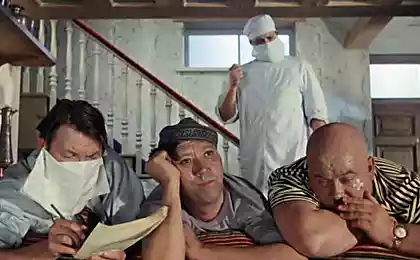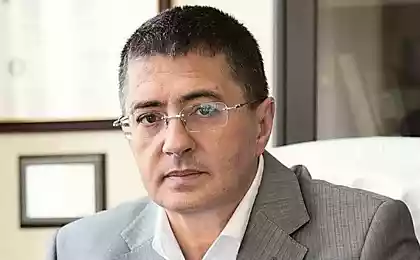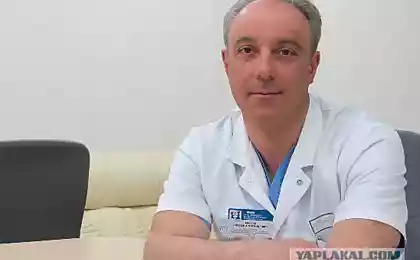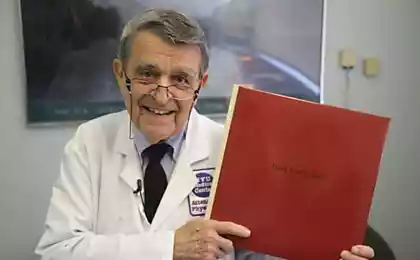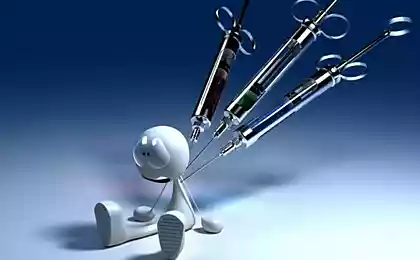576
Vladimir Yavoriv: the Diagnosis of "Vegetative dystonia" in children – the shame of modern Pediatrics
"There are no incurable diseases, there is a lack of knowledge of doctors" V. I. Vernadsky.
Vascular disorders, their nature, symptoms and treatment are one of the urgent problems of modern medicine. This is due to many factors and, above all, the huge prevalence of this disease.
Seventy eight million eight hundred twenty one thousand seven hundred fifty nine
Worldwide adopted the term "neurocirculatory asthenia", introduced for the first time in clinical practice, the American physician B. Oppenheimer in 1918.
So far in our country there is no consensus among doctors of different specialties: pediatricians, cardiologists and neurologists, about the interpretation of the concept of vegetative-vascular dystonia in children and adolescents.
According to numerous epidemiological studies, in populations of autonomic dysfunction, starting puberty, are found in 25-80% of cases. The signs of VSD detected in 80% of children, primarily among urban residents. They can be found in any age period, but more common in girls 7-8 years of age and adolescents. In this regard, "vegetovascular dystonia" (VVD), or a variant of "neurocirculatory dystonia" (NDC) to attract special attention of pediatricians.
Themselves pediatricians honestly admit that "it is not clear whether the NDC is an independent disease or risk factor, a predictor of vascular diseases of the brain, atherosclerosis, cardiac arrhythmias and conduction, coronary heart disease at a young age."
The term VSD had a circulation mainly in tsarist Russia and in the USSR. Contrary to representations "about the punitive nature of psychiatry" in tsarist Russia and the Soviet Union, long before the advent of ICD-10, it was emphasized that this syndrome is not associated with any mental illness and disorders that now also reflects the international medical community.
Neurocirculatory dystonia is characterized as a syndrome dysregulatory disorders of the cardiovascular system, creating the risk of development of hypertension (G. F. lang, 1950).
As an independent disease NDC first introduced the Professor of the Military medical Academy, later academician of the Russian Academy of medical Sciences, N. N. Savitsky (1952), which has allocated 3 of its option:
Academician A. M. Weiner (1996) recommended not to use the term "dystonia". On this occasion, he said: "the Syndrome of vegetative dystonia (SVD) is a manifestation of all forms of disorders of autonomic regulation. In recent years, we give it preference over the syndrome of VSD, since then there is an opportunity to talk about vegetovistseralnyh syndrome of dystonia, and the latter can be subdivided into diverse system of dystonia: vegetarienne, wegotogetherlike, etc. Therefore, we believe that the more General term – SVD".
In relation to non-recognition of the nosological self-sufficiency of the term "dystonia" A. M. Weiner was absolutely right.
Nosology (gr. Νόσος – disease+Greek.λόγος – teaching) – teaching about diseases, allowing to solve the main task of clinical medicine: the knowledge of structure-function relationships in pathology, biological and medical basis of the diseases. Nosology answers questions, at all times have perplexed humanity – what a disease is and how it differs from health, what are the causes and mechanisms of development of illness, recovery or death.
Disease (Latin. morbus) – it occurs in response to the action of pathogenic factors disruption of normal life, health, socially useful activities, the duration of life of the organism and its ability to adapt to constantly changing conditions external and internal environments within simultaneous activation of a protective compensatory-adaptive reactions and mechanisms. The most accepted is the nosological principle, that is, such a classification of diseases which is based on grouping disease related features.
It should be noted that none of the existing classifications of diseases is not entirely satisfactory, however, there was no generally accepted international classification of diseases. In the International classification of diseases 10th revision (ICD-10), adopted in the Russian Federation in 1989, separate nosological forms of "dystonia" and "neurocirculatory dystonia" – not at all. They are classified under the code of mental disorders F45.3: "Somatoform dysfunction of vegetative nervous system."
The world of medical science does not recognize vegetovascular dystonia as an independent nosological form.
Nosological form or nosological unit is considered as "some disease, selected on the basis of established etiology and pathogenesis and/or typical clinical and morphological picture" (Encyclopedic dictionary of medical terms, 1983). But this definition requires clarification and additions, primarily because the majority of the more than 20 thousand of nosological forms, which "features" of modern medicine, the cause of the disease is unknown.
Unfortunately, in recent years, the etiology has gradually become a leading criterion in determining the nosological forms and modern medicine more and more to neglect the value of the primary pathological focus in the development of the disease process. An example of such irresponsible neglect can be pervasive in modern medicine, especially Pediatrics, the terms and diagnoses: "...dystonia", "dyskinesia..." different "...patii": "PN", "nephropathy", "enteropathy", "hepatopathy", "cardiomyopathy", "pneumopathy", "posttraumatic encephalopathy"; various "colic": "liver", "intestinal", "umbilical", etc., which are based on reflexive processes.
Often, as it is explained by the pediatricians, "dystonia", "dyskinesia", various "...patii" and "colic" starts in childhood. This, according to pediatricians, promotes: hypoxia – oxygen deprivation of the fetus during pregnancy and childbirth, birth injuries, other Central nervous system disorders and "diseases of infancy." (Here and grew donkey ears another nosological form. – Primas'. ed.).
As a result of these causes of inferiority in the nervous system, there are disorders of the various organs and systems. For example, from the gastrointestinal tract – frequent vomiting, bloating, unstable stool, decreased appetite, and Central nervous system: a shallow, intermittent, and short sleep with frequent awakenings. Such children are prone to frequent colds with "thermal tails" – maintaining the elevated temperature after recovery, can not tolerate the heat, the heat, the change in the weather, complain of headaches, shortness of breath, often so-called "pent breath and feeling a lump in my throat".
In puberty autonomic dysfunction compounded by the mismatch between the rapid development of internal organs, growth of the organism and retardation of the formation and maturation of nervous and endocrine regulation. At this time usually there are complaints of pain in the heart, interruptions in heart work, heart rate, and recorded the increase or decrease in blood pressure. Frequent neuropsychiatric disorders: fatigue, loss of memory, emotional instability: tearfulness, irritability, irascibility and anxiety.
"Dystonia", "dyskinesia", "....patii" and "....colic" became a haven for ignorance and misunderstandings, and modern pediatricians are no exception.
An example of this can be "epilepsy" in children who experience birth traumatic brain injury. This diagnosis reflects the true etiology and pathogenesis of the pathological process, pediatricians interpret the incomprehensible for us language, multiple terms: "spasmophilia" (in a literal translation from the Latin. – "love spasm"), "prosadochnye hyperkinesis", "febrile convulsions", "anoxic seizures", "affective-respiratory seizures", "hysterical seizures", "laryngospasm", "tetany," "eclampsia, convulsions fifth day, hypoglycemic seizures, convulsions due to hemolytic disease of the newborn," and the children of adolescence, much easier – "disease of puberty".
In the monograph of the eminent scientist pediatric neurologist, Professor A. Yu., Ratner (2006)"Neurology of the newborn" detail slozena pathology of the nervous system of the newborn arising as a pathological and physiological birth. Summarized data on the mechanism and morphology of the birth injuries. The description of unconditioned reflexes of newborns, their clinical options and dynamics depending on the level of damage to the nervous system. Details the pathogenesis and clinical disorders of cerebral circulation, neuro-orthopedic complications, convulsive States, "cervical" myopia and other diseases in children. This book shows all types of perinatal and postnatal pathology ODE and nervous system, which can lead to the development of vascular disorders in children. However, the vast majority of pediatricians, with the exception of a small handful of competent microradiation of Perinatology and pediatric neurologists, continue to adhere to a routine of views on the problem of pathogenesis of VSD.
In pediatric patients still remain controversial issues not only in terms of terminology, classification, etiology, pathogenesis and competency of the clinical diagnosis of VSD, they are also enough for the treatment of VSD (A. S. Senatorov, 2012).
In modern publications on Pediatrics, including solid, pupil of A. S. Nikiforova (2009)"Neurological symptoms, syndromes, symptom and disease," IRR explains as "syndrome diverse clinical manifestations, affecting various organs and systems»…
"Vegetative dystonia is a syndrome," says A. S. Nikiforov. The pathogenesis of this syndrome are abnormalities in the structure and function of Central and/or peripheral divisions of the autonomic nervous system. The pathogenesis of the disease is low resistance to stressful situations with disorder of homeostasis and functional disorders. There is reason to believe that mental and emotional disorders in the IRR can be regarded as secondary, due to somatogenic neurosis-like States".
A slightly different description of the sequence of development of neurogenic and somatic disorders in patients with VSD is described in A. M. Weiner et al.(1991,2001.), A. P. Meshkova (1998). In their opinion, the development of visceral functional disorders, in the majority, due to a defect of the neuro-vegetative way of regulating and graphically associated with dysfunction suprasegmental – subcortical-cortical structures.
Pediatric neurologist S. V. Zaitsev – not in scientific, but in a humorous style, expressed his personal attitude to the problem of VSD. From our point of view, it is absolutely fair, so I decided to quote it almost verbatim: "In conclusion, the fun of walking around the sights of the town called "Old Neuroscience" – says S. V. Zaitsev – we are moving in his legendary district – "dystonia", or abbreviated "IRR". Along the way, engaged in a favorite pastime of advanced researchers recruited in any search engine of the Internet the phrase "vegetovascular dystonia" – and from 130 to 260 thousand pages of answers, and if recruited by the abbreviation "VSD" – that more than 4 million responses! A huge number of popular and scientific information on the IRR, is impressive, and the statistics is simply appalling. According to various official sources, the population of the former USSR VSD is found in 60-80% of cases, and more than half of all diagnoses in the work of the outpatient neurologist – VSD! So what happens if in our tour group of 10 people, 8 of us also have VSD?
Among the inhabitants of the district "IRR" is dominated by "shock troops mentally sedentary" work, experiencing chronic stress and fatigue. It is easy to notice that most of them are anxious-insecure and impressionable nature, experiencing some of the obsessions. But they should not be likened to and compared with the hypochondriacs and malingerers, because they have no conscious imitation of the symptoms, or stand with confidence in the presence of the disease – in its true absence.
But what a paradox! – continues to argue further, S. V. Zaitsev – on the one hand, the man with the "IRR" invariably feels seriously ill, and lives with a constant headache and heart pain, attacks of breathlessness, fear of death etc. for all that, medical statistics have long been convinced that the life expectancy "ve-es-gashnikov" much higher than average in the population, and the indicators of the functional condition of their organs and systems, in-depth exam, much better than peers with no VSD".
How to distinguish the indigenous inhabitants of VSD? – asks S. V. Zaitsev.And immediately responds:
– Pretty easy, just a few minutes of conversation to figure out whether the patient has the following complaints:
A child with these symptoms gets in a good knowledgeable hands of a pediatrician and he diagnosed: "vegetovascular dystonia." And then a long and thorny road of Calvary, that is, to doctors, to ascertain the causes of such violations. Often, "walking through hell" does not lead to relief. Standard begins a chain reaction: every pediatric appointment leads to a series of additional tests and consultations "narrow" experts, the results of which in turn influence further research. Endocrinologists, gastroenterologists, pulmonologists, nephrologists, cardiologists, rheumatology and other "logy", in collaboration with doctors of functional diagnostics and laboratory assistants, bravely trying to diagnose a nonexistent illness and begin to heal, forming the child's sustained belief in the exclusiveness and the severity of the disease. Of course, this belief did not promote improvement of mood, and not makes the disease. The advice to "stop being nervous, a lot of walking and rest, to join the sports section, take Valerian and vitamins" do not have the desired effect.
Finally, after eight rounds of surveys and consultations at the "very narrow" experts, and by excluding various suspicions of somatic pathology: disease of heart and vessels, hypertension, bronchial asthma, hyperthyroidism, infections, gastritis and other diseases, the patient comes to neurologists.
The all-knowing, self-confident neurologist, in passing, except for neurological disorders: migraine, epilepsy, polyneuropathy, cerebrovascular disease and other pathology, with pleasure we start treatment of VSD. But their treatment is not effective…
In the end, children with VSD dobredayut to psychotherapists. And only then they get the right(?) diagnosis and adequate(?) qualified assistance.
And like, you sigh contentedly and think, what a terrible tale comes to a happy ending? But, unfortunately, this does not happen.... Psych also does not guarantee a pleasant cure. Severe panic attacks plus "the efforts of" reputable pharmaceutical companies are forced to resort to the appointment of serious psychotropic drugs."
These doctors provide a great service "to the International pharmaceutical cartel." They prescribe children drugs: tranquilizers (seduksen, Relanium, mebicar), "autonomic markers" (belloid, bellypan), antidepressants (amitriptyline, azafen and coaxil) and to relieve feelings of anxiety, fear and mental emotional tension – psychosedative prescription drugs (Mazeppa, grandaxinum and nozepam).
And children get used addicted to pills…
But these pharmaceutical preparations according to the intention of their creators, do not resolve the root cause of disease and heal children from the IRR. Deliberately avoiding curing the disease, these pharmaceutical drugs have long-term destructive side-effects, potentially generating a lot of new diseases, and, consequently, the creation of new markets for drugs. Therefore, prescribing such drugs to children, doctors commit a crime, because their "treatment" can only the formation of the future legions of young addicts!!! For all these inhuman acts of our medicine once happen to meet! – Primas'. ed.
"Such treatment, in a milder form says S. V. Zaitsev – dangerous and harmful, because it may further exacerbate systemic disorders and depressive symptoms, can cause unpleasant side effects, and thus undermine the credibility of the medicine. Finally, the last stop on our informative tour.
And a little trick: did You know that VSD is no such diagnosis! Dystonia long – outdated medical term, which had previously joined a huge group of very diverse diseases. In the USSR this universal diagnosis like therapy, Pediatrics, neurology and psychiatry because it allowed doctors to work with more comfort, deftly juggling complaints, symptoms and pills.
Everything is simple and logical! Why spend a huge amount of precious medical time, effort and patience, and dokapyvayas to the truth?
Thus, currently, the diagnosis of VSD is a common "urban trash". Sincerely mistaken in connection with lack of knowledge, time and opportunity, or simply reluctance, to clarify the essence of disorder, the doctors in her gracefully dropping numerous complaints of the patient! – with these words, the pediatrician S. V. Zaitsev concluded his journey through the city called "Old Neurology".
From the foregoing it can be concluded that "dystonia" is just one of the syndromes of the visible part of "iceberg" called "Vertebrogenic diseases of the nervous system (WSNS)". Its etiology and pathogenesis pediatricians interpret, not giving value, the main culprit for the development of functional neurological and vascular disorders, the primary pathological focus localized in the underwater invisible part of this "iceberg" –the spine.
Therefore, many pediatricians explanations of the etiology and pathogenesis of functional syndromes, vascular disorders should be considered erroneous, and in the future we will try to prove it.
What exactly is organic changes in the spine are the main cause, and what functional syndromes, manifested under the guise of VSD? But, today in this sacramental question we do not find in Pediatrics a clear answer.
The author of these lines, in 1960 graduated from the pediatric faculty of the Odessa medical Institute, and later as a neurosurgeon and Beijing, over a period of many years of medical practice, has seen hundreds of "ve-es-Dachnik" children. So put on a daunting challenge: in the pages of the monograph"Vertebral vascular syndromes in children", published in Germany in September 2013, comment, rooted in Pediatrics routine interpretation of the etiology, pathogenesis and treatment of VSD. Our review is consistent with the data of the study of this disease, the ongoing progressive modern pediatric neurologists, pediatric orthopedics, traumatologists, vertebrologists, vertebronevrologii, experts manual medicine, physicians and other eminent scientists.
In writing this section on the desktop was always preserved since student time, loyal Advisor, of the age of the author – the student of M. S. Maslova "Childhood diseases" published in 1935, which, mind you(!) there is not a single mention of the above diagnoses vascular disorders in children.
The cause of "IRR" is often instability of the vertebral motor segments (MPD) of the cervical spine. Therefore, the slightest displacement of the vertebral bodies may cause mechanical irritation of the nerve roots and reflex spasm of the vertebral arteries.
Pathological irritate nerve roots is pain in the occipital-parietal region of the head, sometimes irradiiruet in the ear, temple and eye pain hair roots in this area.
Reflex spasm of the vertebral arteries, manifested by the range of symptoms of ischemia, stem parts of the brain and the cerebellum: a noise in the head, dizziness, blurred before my eyes, unsteadiness when walking, rapid heartbeat, increased blood pressure, etc.
The first symptoms begin to appear in girls in the 8-10 year old boys of 9-12 years of age. And then the pediatricians establish the diagnosis of "VSD" and begin to "heal".
However, any drugs do not cure, they only bring temporary relief.
The causes of the instability of PDS can be different, and to find out the real reason, careful anamnestic investigation.
The only pathognomonic treatment method is manual correction of the affected PDS, and mandatory immobilization of the cervical collar is congruent with a period of 35-40 days. During this time in the "actual" PDS formed capsule strong ligaments to hold the vertebrae in normal anatomical and physiological position, and any previous clinical symptoms will disappear.
To fight the stagnancy and routine in medicine, it is not necessary to be a University Professor or a Nobel prize winner. You just need to believe that in the future in Pediatrics a diagnosis of VSD, GIT, dyskinesia other systems, diseases of infancy and puberty are, in fact, forgotten.
I believe my forty year experience of treatment of this pathology. published
Author: Vladimir Yavoriv
P. S. And remember, only by changing their consumption — together we change the world! ©
Source: zrostaymaluk.com.ua/ua/poradi_likariv/diagnoz_vegetososudistaya_distoniya_u_detej_%E2%80%93_pozor_sovremennoj_pediatrii
Vascular disorders, their nature, symptoms and treatment are one of the urgent problems of modern medicine. This is due to many factors and, above all, the huge prevalence of this disease.
Seventy eight million eight hundred twenty one thousand seven hundred fifty nine
Worldwide adopted the term "neurocirculatory asthenia", introduced for the first time in clinical practice, the American physician B. Oppenheimer in 1918.
So far in our country there is no consensus among doctors of different specialties: pediatricians, cardiologists and neurologists, about the interpretation of the concept of vegetative-vascular dystonia in children and adolescents.
According to numerous epidemiological studies, in populations of autonomic dysfunction, starting puberty, are found in 25-80% of cases. The signs of VSD detected in 80% of children, primarily among urban residents. They can be found in any age period, but more common in girls 7-8 years of age and adolescents. In this regard, "vegetovascular dystonia" (VVD), or a variant of "neurocirculatory dystonia" (NDC) to attract special attention of pediatricians.
Themselves pediatricians honestly admit that "it is not clear whether the NDC is an independent disease or risk factor, a predictor of vascular diseases of the brain, atherosclerosis, cardiac arrhythmias and conduction, coronary heart disease at a young age."
The term VSD had a circulation mainly in tsarist Russia and in the USSR. Contrary to representations "about the punitive nature of psychiatry" in tsarist Russia and the Soviet Union, long before the advent of ICD-10, it was emphasized that this syndrome is not associated with any mental illness and disorders that now also reflects the international medical community.
Neurocirculatory dystonia is characterized as a syndrome dysregulatory disorders of the cardiovascular system, creating the risk of development of hypertension (G. F. lang, 1950).
As an independent disease NDC first introduced the Professor of the Military medical Academy, later academician of the Russian Academy of medical Sciences, N. N. Savitsky (1952), which has allocated 3 of its option:
- cardiac;
- hypertonic;
- hypotonic.
Academician A. M. Weiner (1996) recommended not to use the term "dystonia". On this occasion, he said: "the Syndrome of vegetative dystonia (SVD) is a manifestation of all forms of disorders of autonomic regulation. In recent years, we give it preference over the syndrome of VSD, since then there is an opportunity to talk about vegetovistseralnyh syndrome of dystonia, and the latter can be subdivided into diverse system of dystonia: vegetarienne, wegotogetherlike, etc. Therefore, we believe that the more General term – SVD".
In relation to non-recognition of the nosological self-sufficiency of the term "dystonia" A. M. Weiner was absolutely right.
Nosology (gr. Νόσος – disease+Greek.λόγος – teaching) – teaching about diseases, allowing to solve the main task of clinical medicine: the knowledge of structure-function relationships in pathology, biological and medical basis of the diseases. Nosology answers questions, at all times have perplexed humanity – what a disease is and how it differs from health, what are the causes and mechanisms of development of illness, recovery or death.
Disease (Latin. morbus) – it occurs in response to the action of pathogenic factors disruption of normal life, health, socially useful activities, the duration of life of the organism and its ability to adapt to constantly changing conditions external and internal environments within simultaneous activation of a protective compensatory-adaptive reactions and mechanisms. The most accepted is the nosological principle, that is, such a classification of diseases which is based on grouping disease related features.
It should be noted that none of the existing classifications of diseases is not entirely satisfactory, however, there was no generally accepted international classification of diseases. In the International classification of diseases 10th revision (ICD-10), adopted in the Russian Federation in 1989, separate nosological forms of "dystonia" and "neurocirculatory dystonia" – not at all. They are classified under the code of mental disorders F45.3: "Somatoform dysfunction of vegetative nervous system."
The world of medical science does not recognize vegetovascular dystonia as an independent nosological form.
Nosological form or nosological unit is considered as "some disease, selected on the basis of established etiology and pathogenesis and/or typical clinical and morphological picture" (Encyclopedic dictionary of medical terms, 1983). But this definition requires clarification and additions, primarily because the majority of the more than 20 thousand of nosological forms, which "features" of modern medicine, the cause of the disease is unknown.
Unfortunately, in recent years, the etiology has gradually become a leading criterion in determining the nosological forms and modern medicine more and more to neglect the value of the primary pathological focus in the development of the disease process. An example of such irresponsible neglect can be pervasive in modern medicine, especially Pediatrics, the terms and diagnoses: "...dystonia", "dyskinesia..." different "...patii": "PN", "nephropathy", "enteropathy", "hepatopathy", "cardiomyopathy", "pneumopathy", "posttraumatic encephalopathy"; various "colic": "liver", "intestinal", "umbilical", etc., which are based on reflexive processes.
Often, as it is explained by the pediatricians, "dystonia", "dyskinesia", various "...patii" and "colic" starts in childhood. This, according to pediatricians, promotes: hypoxia – oxygen deprivation of the fetus during pregnancy and childbirth, birth injuries, other Central nervous system disorders and "diseases of infancy." (Here and grew donkey ears another nosological form. – Primas'. ed.).
As a result of these causes of inferiority in the nervous system, there are disorders of the various organs and systems. For example, from the gastrointestinal tract – frequent vomiting, bloating, unstable stool, decreased appetite, and Central nervous system: a shallow, intermittent, and short sleep with frequent awakenings. Such children are prone to frequent colds with "thermal tails" – maintaining the elevated temperature after recovery, can not tolerate the heat, the heat, the change in the weather, complain of headaches, shortness of breath, often so-called "pent breath and feeling a lump in my throat".
In puberty autonomic dysfunction compounded by the mismatch between the rapid development of internal organs, growth of the organism and retardation of the formation and maturation of nervous and endocrine regulation. At this time usually there are complaints of pain in the heart, interruptions in heart work, heart rate, and recorded the increase or decrease in blood pressure. Frequent neuropsychiatric disorders: fatigue, loss of memory, emotional instability: tearfulness, irritability, irascibility and anxiety.
"Dystonia", "dyskinesia", "....patii" and "....colic" became a haven for ignorance and misunderstandings, and modern pediatricians are no exception.
An example of this can be "epilepsy" in children who experience birth traumatic brain injury. This diagnosis reflects the true etiology and pathogenesis of the pathological process, pediatricians interpret the incomprehensible for us language, multiple terms: "spasmophilia" (in a literal translation from the Latin. – "love spasm"), "prosadochnye hyperkinesis", "febrile convulsions", "anoxic seizures", "affective-respiratory seizures", "hysterical seizures", "laryngospasm", "tetany," "eclampsia, convulsions fifth day, hypoglycemic seizures, convulsions due to hemolytic disease of the newborn," and the children of adolescence, much easier – "disease of puberty".
In the monograph of the eminent scientist pediatric neurologist, Professor A. Yu., Ratner (2006)"Neurology of the newborn" detail slozena pathology of the nervous system of the newborn arising as a pathological and physiological birth. Summarized data on the mechanism and morphology of the birth injuries. The description of unconditioned reflexes of newborns, their clinical options and dynamics depending on the level of damage to the nervous system. Details the pathogenesis and clinical disorders of cerebral circulation, neuro-orthopedic complications, convulsive States, "cervical" myopia and other diseases in children. This book shows all types of perinatal and postnatal pathology ODE and nervous system, which can lead to the development of vascular disorders in children. However, the vast majority of pediatricians, with the exception of a small handful of competent microradiation of Perinatology and pediatric neurologists, continue to adhere to a routine of views on the problem of pathogenesis of VSD.
In pediatric patients still remain controversial issues not only in terms of terminology, classification, etiology, pathogenesis and competency of the clinical diagnosis of VSD, they are also enough for the treatment of VSD (A. S. Senatorov, 2012).
In modern publications on Pediatrics, including solid, pupil of A. S. Nikiforova (2009)"Neurological symptoms, syndromes, symptom and disease," IRR explains as "syndrome diverse clinical manifestations, affecting various organs and systems»…
"Vegetative dystonia is a syndrome," says A. S. Nikiforov. The pathogenesis of this syndrome are abnormalities in the structure and function of Central and/or peripheral divisions of the autonomic nervous system. The pathogenesis of the disease is low resistance to stressful situations with disorder of homeostasis and functional disorders. There is reason to believe that mental and emotional disorders in the IRR can be regarded as secondary, due to somatogenic neurosis-like States".
A slightly different description of the sequence of development of neurogenic and somatic disorders in patients with VSD is described in A. M. Weiner et al.(1991,2001.), A. P. Meshkova (1998). In their opinion, the development of visceral functional disorders, in the majority, due to a defect of the neuro-vegetative way of regulating and graphically associated with dysfunction suprasegmental – subcortical-cortical structures.
Pediatric neurologist S. V. Zaitsev – not in scientific, but in a humorous style, expressed his personal attitude to the problem of VSD. From our point of view, it is absolutely fair, so I decided to quote it almost verbatim: "In conclusion, the fun of walking around the sights of the town called "Old Neuroscience" – says S. V. Zaitsev – we are moving in his legendary district – "dystonia", or abbreviated "IRR". Along the way, engaged in a favorite pastime of advanced researchers recruited in any search engine of the Internet the phrase "vegetovascular dystonia" – and from 130 to 260 thousand pages of answers, and if recruited by the abbreviation "VSD" – that more than 4 million responses! A huge number of popular and scientific information on the IRR, is impressive, and the statistics is simply appalling. According to various official sources, the population of the former USSR VSD is found in 60-80% of cases, and more than half of all diagnoses in the work of the outpatient neurologist – VSD! So what happens if in our tour group of 10 people, 8 of us also have VSD?
Among the inhabitants of the district "IRR" is dominated by "shock troops mentally sedentary" work, experiencing chronic stress and fatigue. It is easy to notice that most of them are anxious-insecure and impressionable nature, experiencing some of the obsessions. But they should not be likened to and compared with the hypochondriacs and malingerers, because they have no conscious imitation of the symptoms, or stand with confidence in the presence of the disease – in its true absence.
But what a paradox! – continues to argue further, S. V. Zaitsev – on the one hand, the man with the "IRR" invariably feels seriously ill, and lives with a constant headache and heart pain, attacks of breathlessness, fear of death etc. for all that, medical statistics have long been convinced that the life expectancy "ve-es-gashnikov" much higher than average in the population, and the indicators of the functional condition of their organs and systems, in-depth exam, much better than peers with no VSD".
How to distinguish the indigenous inhabitants of VSD? – asks S. V. Zaitsev.And immediately responds:
– Pretty easy, just a few minutes of conversation to figure out whether the patient has the following complaints:
- Fatigue, weakness, lethargy, drowsiness, bad mood and anxiety, poor work capacity and weather dependent.
- Headache, dizziness, shakiness, nausea, sweating, dry mouth, fainting, tremors and convulsions of arms and legs, vision changes and hearing.
- Sensation of heat or chills, internal tremor and pulsation, lump in throat, heaviness in chest, feeling of choking, shortness of breath, numbness and tingling in the hands and feet.
- Palpitations, rapid heart rate, discomfort and pain in the heart, fluctuations in blood pressure, red spots on the face and neck, cold hands and feet.
- Pain and rumbling in the abdomen, irregular bowel movement and urination.
A child with these symptoms gets in a good knowledgeable hands of a pediatrician and he diagnosed: "vegetovascular dystonia." And then a long and thorny road of Calvary, that is, to doctors, to ascertain the causes of such violations. Often, "walking through hell" does not lead to relief. Standard begins a chain reaction: every pediatric appointment leads to a series of additional tests and consultations "narrow" experts, the results of which in turn influence further research. Endocrinologists, gastroenterologists, pulmonologists, nephrologists, cardiologists, rheumatology and other "logy", in collaboration with doctors of functional diagnostics and laboratory assistants, bravely trying to diagnose a nonexistent illness and begin to heal, forming the child's sustained belief in the exclusiveness and the severity of the disease. Of course, this belief did not promote improvement of mood, and not makes the disease. The advice to "stop being nervous, a lot of walking and rest, to join the sports section, take Valerian and vitamins" do not have the desired effect.
Finally, after eight rounds of surveys and consultations at the "very narrow" experts, and by excluding various suspicions of somatic pathology: disease of heart and vessels, hypertension, bronchial asthma, hyperthyroidism, infections, gastritis and other diseases, the patient comes to neurologists.
The all-knowing, self-confident neurologist, in passing, except for neurological disorders: migraine, epilepsy, polyneuropathy, cerebrovascular disease and other pathology, with pleasure we start treatment of VSD. But their treatment is not effective…
In the end, children with VSD dobredayut to psychotherapists. And only then they get the right(?) diagnosis and adequate(?) qualified assistance.
And like, you sigh contentedly and think, what a terrible tale comes to a happy ending? But, unfortunately, this does not happen.... Psych also does not guarantee a pleasant cure. Severe panic attacks plus "the efforts of" reputable pharmaceutical companies are forced to resort to the appointment of serious psychotropic drugs."
These doctors provide a great service "to the International pharmaceutical cartel." They prescribe children drugs: tranquilizers (seduksen, Relanium, mebicar), "autonomic markers" (belloid, bellypan), antidepressants (amitriptyline, azafen and coaxil) and to relieve feelings of anxiety, fear and mental emotional tension – psychosedative prescription drugs (Mazeppa, grandaxinum and nozepam).
And children get used addicted to pills…
But these pharmaceutical preparations according to the intention of their creators, do not resolve the root cause of disease and heal children from the IRR. Deliberately avoiding curing the disease, these pharmaceutical drugs have long-term destructive side-effects, potentially generating a lot of new diseases, and, consequently, the creation of new markets for drugs. Therefore, prescribing such drugs to children, doctors commit a crime, because their "treatment" can only the formation of the future legions of young addicts!!! For all these inhuman acts of our medicine once happen to meet! – Primas'. ed.
"Such treatment, in a milder form says S. V. Zaitsev – dangerous and harmful, because it may further exacerbate systemic disorders and depressive symptoms, can cause unpleasant side effects, and thus undermine the credibility of the medicine. Finally, the last stop on our informative tour.
And a little trick: did You know that VSD is no such diagnosis! Dystonia long – outdated medical term, which had previously joined a huge group of very diverse diseases. In the USSR this universal diagnosis like therapy, Pediatrics, neurology and psychiatry because it allowed doctors to work with more comfort, deftly juggling complaints, symptoms and pills.
Everything is simple and logical! Why spend a huge amount of precious medical time, effort and patience, and dokapyvayas to the truth?
Thus, currently, the diagnosis of VSD is a common "urban trash". Sincerely mistaken in connection with lack of knowledge, time and opportunity, or simply reluctance, to clarify the essence of disorder, the doctors in her gracefully dropping numerous complaints of the patient! – with these words, the pediatrician S. V. Zaitsev concluded his journey through the city called "Old Neurology".
From the foregoing it can be concluded that "dystonia" is just one of the syndromes of the visible part of "iceberg" called "Vertebrogenic diseases of the nervous system (WSNS)". Its etiology and pathogenesis pediatricians interpret, not giving value, the main culprit for the development of functional neurological and vascular disorders, the primary pathological focus localized in the underwater invisible part of this "iceberg" –the spine.
Therefore, many pediatricians explanations of the etiology and pathogenesis of functional syndromes, vascular disorders should be considered erroneous, and in the future we will try to prove it.
What exactly is organic changes in the spine are the main cause, and what functional syndromes, manifested under the guise of VSD? But, today in this sacramental question we do not find in Pediatrics a clear answer.
The author of these lines, in 1960 graduated from the pediatric faculty of the Odessa medical Institute, and later as a neurosurgeon and Beijing, over a period of many years of medical practice, has seen hundreds of "ve-es-Dachnik" children. So put on a daunting challenge: in the pages of the monograph"Vertebral vascular syndromes in children", published in Germany in September 2013, comment, rooted in Pediatrics routine interpretation of the etiology, pathogenesis and treatment of VSD. Our review is consistent with the data of the study of this disease, the ongoing progressive modern pediatric neurologists, pediatric orthopedics, traumatologists, vertebrologists, vertebronevrologii, experts manual medicine, physicians and other eminent scientists.
In writing this section on the desktop was always preserved since student time, loyal Advisor, of the age of the author – the student of M. S. Maslova "Childhood diseases" published in 1935, which, mind you(!) there is not a single mention of the above diagnoses vascular disorders in children.
The cause of "IRR" is often instability of the vertebral motor segments (MPD) of the cervical spine. Therefore, the slightest displacement of the vertebral bodies may cause mechanical irritation of the nerve roots and reflex spasm of the vertebral arteries.
Pathological irritate nerve roots is pain in the occipital-parietal region of the head, sometimes irradiiruet in the ear, temple and eye pain hair roots in this area.
Reflex spasm of the vertebral arteries, manifested by the range of symptoms of ischemia, stem parts of the brain and the cerebellum: a noise in the head, dizziness, blurred before my eyes, unsteadiness when walking, rapid heartbeat, increased blood pressure, etc.
The first symptoms begin to appear in girls in the 8-10 year old boys of 9-12 years of age. And then the pediatricians establish the diagnosis of "VSD" and begin to "heal".
However, any drugs do not cure, they only bring temporary relief.
The causes of the instability of PDS can be different, and to find out the real reason, careful anamnestic investigation.
The only pathognomonic treatment method is manual correction of the affected PDS, and mandatory immobilization of the cervical collar is congruent with a period of 35-40 days. During this time in the "actual" PDS formed capsule strong ligaments to hold the vertebrae in normal anatomical and physiological position, and any previous clinical symptoms will disappear.
To fight the stagnancy and routine in medicine, it is not necessary to be a University Professor or a Nobel prize winner. You just need to believe that in the future in Pediatrics a diagnosis of VSD, GIT, dyskinesia other systems, diseases of infancy and puberty are, in fact, forgotten.
I believe my forty year experience of treatment of this pathology. published
Author: Vladimir Yavoriv
P. S. And remember, only by changing their consumption — together we change the world! ©
Source: zrostaymaluk.com.ua/ua/poradi_likariv/diagnoz_vegetososudistaya_distoniya_u_detej_%E2%80%93_pozor_sovremennoj_pediatrii




